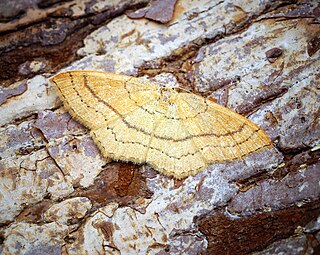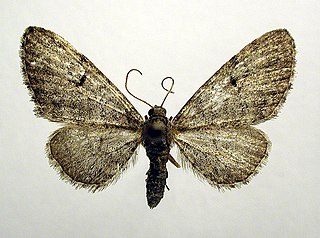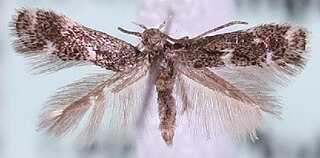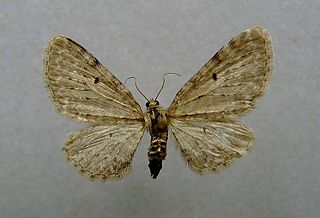
Cyclophora punctaria, the maiden's blush, is a moth of the family Geometridae. The species was first described by Carl Linnaeus in his 1758 10th edition of Systema Naturae. The species is mainly prevalent in Central and Eastern Europe. In the north, its distribution extends to southern Fennoscandia and the British Isles, in the west via France to parts of northern Spain, in the south via Italy, the Balkan Peninsula to Asia Minor. The eastern border of the distribution is roughly the Ural. In the Caucasus area, the nominate subspecies is replaced by the subspecies C. punctaria fritzae. The range of this subspecies extends as far as Iran.Cyclophora punctaria is found mainly in wooded areas with oak scrub and oak forests. In Central Europe it rises up to 700 metres in the hills, rarely up to 1,200 metres in the Alps, and regularly rises to 1,300 metres in southern Europe.

Cyclophora linearia, the clay triple-lines, is a moth of the family Geometridae. The species was first described by Jacob Hübner in 1799 and it can be found in Europe and Britain.

Cyclophora ruficiliaria, the Jersey mocha, is a moth of the family Geometridae. The species was first described by Gottlieb August Wilhelm Herrich-Schäffer in 1855. It can be found in Europe, in particular the Channel Islands as well as other parts of the mainland United Kingdom.

Asthena is a genus of moths in the family Geometridae.

Pero is a genus of moths in the family Geometridae erected by Gottlieb August Wilhelm Herrich-Schäffer in 1855.

Semaeopus is a genus of moths in the family Geometridae erected by Gottlieb August Wilhelm Herrich-Schäffer in 1855.

Sericoptera is a New World genus of moths in the family Geometridae erected by Gottlieb August Wilhelm Herrich-Schäffer in 1855. Adults of species in Sericoptera typically have white to cream wings with pale brown bands on the outer wings, sometimes dashed. Some but not all species have yellowish and dark blotches as additional wing markings. In some species, the bands are faint or absent. Species occur in the New World from Canada to Bolivia.

Stigmella splendidissimella is a moth of the family Nepticulidae. It is found from Scandinavia to Italy and from Ireland to the Crimea. It is not found in the Iberian Peninsula and the Balkan Peninsula.

Stigmella regiella is a moth of the family Nepticulidae. It is found in most of Europe, east to the eastern part of the Palearctic realm.

Ectoedemia decentella is a moth of the family Nepticulidae found in Europe. It was described in 1855, by the German entomologist and physician, Gottlieb August Wilhelm Herrich-Schäffer.

Leucoptera lustratella is a moth in the Lyonetiidae family. It is found from Fennoscandia to the Pyrenees and Italy and from France to Belarus and Romania.
Bucculatrix artemisiella is a species of moth of the family Bucculatricidae. It is found in most of Europe. It was first described by Gottlieb August Wilhelm Herrich-Schäffer in 1855.

Chlorissa viridata, the small grass emerald, is a moth of the family Geometridae. The species was first described by Carl Linnaeus in his 1758 10th edition of Systema Naturae. It is found from western Europe to the eastern Palearctic.

Eupithecia egenaria, the pauper pug, is a moth of the family Geometridae. It is known from almost all of Europe, except Portugal, Ireland and the southern part of the Balkan Peninsula.

Elachista tetragonella is a moth of the family Elachistidae. It is found from Fennoscandia to Spain and Italy and from France to Bulgaria.

Elachista geminatella is a moth of the family Elachistidae found in Europe.

Eupithecia veratraria is a moth of the family Geometridae first described by Gottlieb August Wilhelm Herrich-Schäffer in 1848. It is found from the mountainous areas of Europe and Asia up to Japan.
Eupithecia gratiosata is a moth in the family Geometridae. It is found in France, the Iberian Peninsula, Italy, the Balkan Peninsula, Ukraine, Poland, Russia, Turkmenistan, Kazakhstan, the Near East and Iran.
Asthena lactularia is a moth in the family Geometridae first described by Gottlieb August Wilhelm Herrich-Schäffer in 1855. It is found in southern Spain.

Scythris picaepennis is a moth of the family Scythrididae first described by the German entomologist Gottlieb August Wilhelm Herrich-Schäffer in 1855. It is found in Europe.

















